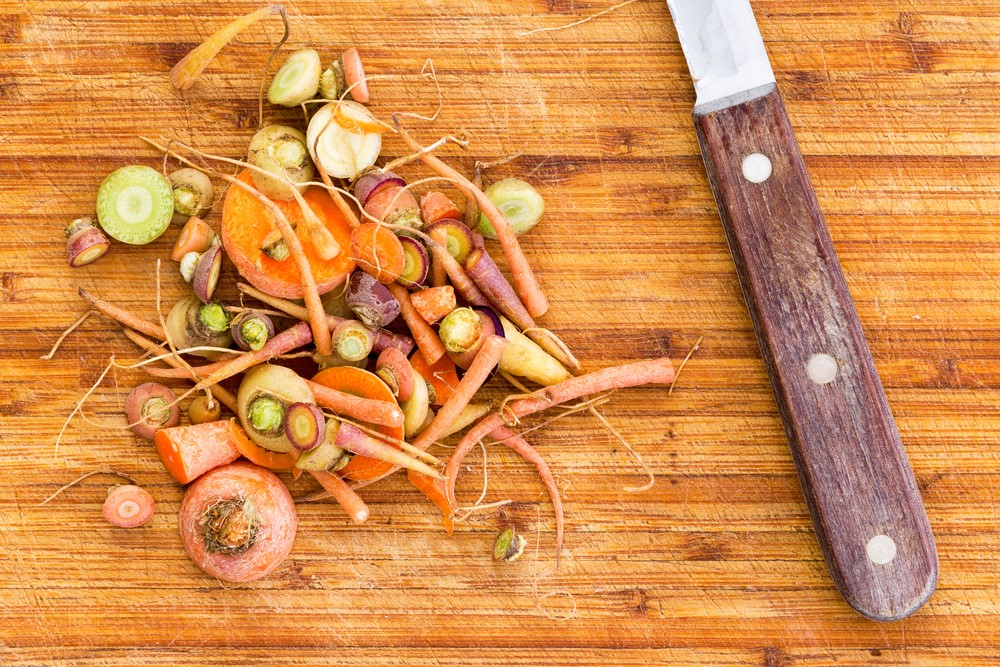Looking for a way to fight climate change? Look no further than your kitchen. From eating leftovers to using eco-friendly garbage bags, helping the planet is almost as easy as reaching for a midnight snack.
Composting your food scraps is one of the best ways you can reduce greenhouse gas that is 25 times more effective at trapping heat than carbon dioxide.
Food waste is a significant producer of methane, a noxious gas that makes up about 20 percent of greenhouse gas emissions globally. Americans send 40 percent of our food to landfills. These landfills generate methane emissions that are equivalent to about 20.3 million passenger cars.
You can do a lot to cut your food waste at home. But what about those eggshells or banana peels? Even city dwellers living in apartments can easily store and compost their unavoidable food waste.

Source: Ashley-Belle Burns/Shutterstock.com
1. Decide What Composting Means for You
Will you use the resulting compost? If you have houseplants or a balcony garden, then an indoor composting container that transforms your leftover sticky rice into black gold will help you keep your begonias blooming.
On the other hand, if you’re composting to save the planet (which is the best reason to compost, as far as we’re concerned), then you need a composting bin that will store your food waste sans the smell and pests until you can drop it off at your local composting site.
2. Finding the Right Composting Container
Whether you’re creating your own compost or donating your food scraps to a community-wide effort, follow these tips before you start shopping.
- Decide where you want to keep your composting container. Generally speaking, creating your own compost from start to finish requires a bit more space. However, there are countertop composting bins that will get the job done for apartment-dwellers.
- Consider how much food waste you’ll send to compost. Remember, on average, we waste 40 percent of our food. So be realistic. You can find out with a quick phone call if your municipal composting facility takes leftover chicken bones or other meat and dairy products.
- Determine your budget. Bins for making and using your own compost vary widely in cost. Larger doesn’t mean more costly in this case, either. Often, the inexpensive versions of these bins are larger.

Source: Ozgur Cosjun/Shutterstock.com
3. Choosing a Container for Food Scraps for Your Local Composting Facility
Dropping your food waste off at your local composting site? That’s great! You’re doing your part for a healthier planet. But even eco-heroes want a clean-smelling kitchen. Follow these tips to avoid pinching your nose or swatting away fruit flies.
- Use a container large enough to fit about a week’s worth of food scraps to avoid too many trips to your drop-off site.
- Consider a compost container for the freezer, especially if you’re collecting meat scraps.
- Make sure your countertop compost container has a tight lid to keep the pests away.
- Choose a countertop composting bin with a replaceable carbon filter to reduce odor.
- If you’re shopping for a larger compost container that can fit 30-gallon compostable trash bags, look for one with a foot pedal to open the lid.
4. Choosing a Container to Compost Your Food Waste
Are you making compost to use in your own patio garden? Bravo! Your balcony will be the envy of the building. Let’s find the right compost bin to send your shoots to the sky.
- Electric compost bins are an easy solution for composting in the city. These appliances can be small enough to fit on your countertop or large enough to compost a week’s worth of food scraps. And many models generate black dirt within hours.
- Tray compost bins are less expensive, but take up more space than an electric food recycler. Tray compost bins work like traditional composting, using worms to process food scraps.
- DIY compost bins are cost-effective and fun to make. Check out the EPA’s easy instructions for building a compost bin.

Source: Isa Long/Shutterstock.com
5. Include These Three Ingredients in Your Non-Electric Compost Bin
Besides worms, you need three essential ingredients for successfully composting in a non-electric bin: “green” ingredients, “brown” ingredients and water. Follow these tips to get the recipe right.
- Green compost ingredients are so-called because they add nitrogen to your compost. You already have green ingredients covered with your kitchen scraps, even your brown coffee grounds.
- Brown compost ingredients provide carbon, usually dead leaves. Don’t worry–even if you don’t have a yard to rake, you can add brown ingredients to your compost in the form of shredded paper.
- You need just the right amount of water to keep your composting running smoothly. Your compost should be as saturated as a wrung-out sponge.
6. More Tips for Making Your Own Compost
Whether you power your composter with worms or the outlet, follow these tips for composting success.
- Don’t add meat or dairy products. Your large municipal composting may take these ingredients, but they’ll quickly create a stench that will bring your neighbors to your door with pitchforks.
- Remove stickers from produce. Those pesky labels won’t break down.
- Compost your paper towels and coffee filters. Most people don’t think about composting these common paper products.
- Remove the staple and string from your teabag. Also, make sure your tea company isn’t using plastic tea bags.
- Go ahead and compost your hamster’s bedding as a brown ingredient. But toss out your used kitty litter. Even your all-natural litter isn’t compostable once your cat uses it.
Be Green the Easy and Fun Way with Composting
After biking to work and washing the peanut butter from the jar, you deserve an eco-friendly way to unwind. Keeping pet worms or digging around in your potted herbs is just the thing. Even taking a stroll to drop your scraps off at the community garden is an easy way to take a big bite out of your carbon footprint.




